阅读理解之概括段落大意
语文阅读理解常考题型和答题技巧之概括文章主要内容
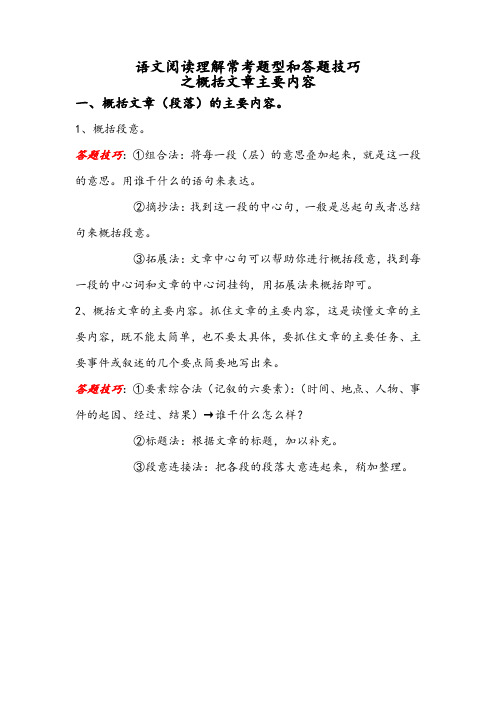
语文阅读理解常考题型和答题技巧
之概括文章主要内容
一、概括文章(段落)的主要内容。
1、概括段意。
答题技巧:①组合法:将每一段(层)的意思叠加起来,就是这一段的意思。
用谁干什么的语句来表达。
②摘抄法:找到这一段的中心句,一般是总起句或者总结句来概括段意。
③拓展法:文章中心句可以帮助你进行概括段意,找到每一段的中心词和文章的中心词挂钩,用拓展法来概括即可。
2、概括文章的主要内容。
抓住文章的主要内容,这是读懂文章的主要内容,既不能太简单,也不要太具体,要抓住文章的主要任务、主要事件或叙述的几个要点简要地写出来。
答题技巧:①要素综合法(记叙的六要素):(时间、地点、人物、事件的起因、经过、结果)→谁干什么怎么样?
②标题法:根据文章的标题,加以补充。
③段意连接法:把各段的段落大意连起来,稍加整理。
概括段落大意的方法和技巧

概括段落大意的方法和技巧概括段落大意是指将一段文字的内容进行简明扼要的总结和概括,提炼出其主要观点、重要信息和意义。
以下是概括段落大意的几种方法和技巧:一、阅读和理解段落内容:在概括段落大意之前,首先要认真阅读和理解段落内容。
注意段落中的主题、观点、重要信息和修辞手法,对段落内容有一个全面的了解。
二、找出段落主题和中心思想:在阅读段落时,要特别注意段落的主题和中心思想。
段落主题通常是在段落开头或结尾明确提出的,而中心思想则是贯穿整个段落的。
三、提取重要信息:在段落中,有些信息是重要的,需要特别注意。
例如,段落中的事实、数据、例子、论证和结论等都是重要的信息,需要认真提取和概括。
四、简化和概括:在概括段落大意时,需要将段落内容进行简化和概括。
去掉不必要的细节和修辞,保留段落的主题、中心思想、重要信息和意义。
五、总结和归纳:在概括段落大意时,需要将段落内容进行总结和归纳。
将段落中的各个观点和信息进行有机整合,形成一段简明扼要的大意。
六、注意段落结构:段落结构通常有开头、中间和结尾三个部分。
开头通常提出主题和中心思想,中间通常是对主题和中心思想的论证和说明,结尾通常是对段落的总结和结论。
七、注意关键词和短语:在段落中,有些关键词和短语可以帮助概括段落大意。
例如,一些重要的概念、术语、数字和例子等都是关键词和短语,可以帮助概括段落大意。
八、练习和提高:概括段落大意需要不断的练习和提高。
通过多读多练,可以提高概括段落大意的技能和能力。
总之,概括段落大意需要认真阅读和理解段落内容,提取重要信息,简化和概括,总结和归纳,同时注意段落结构、关键词和短语,以及多读多练。
这些方法和技巧可以帮助您更好地概括段落大意,提高阅读和理解能力。
四年级语文阅读理解之概括段落大意(有答案)汇编

阅读指导之概括段落大意(有答案)阅读文章时,养成一边阅读一边概括段意的好习惯,对自己写作文时选材组材,布局谋篇都是有帮助的。
要求概括段意做到言简意明,不能罗里罗嗦,说个没完,什么是准确呢?就是抓住段的实质,不要偏离段的主要内容。
(一)用段的中心句概括段落大意。
△中心句指明段的写作范围△中心句突出段的主要内容△中心句归纳出段的思想要点例1小城里每个庭院都栽了很多树。
有桉树、椰子树、橄榄树、凤凰树,还有别的亚热带树木。
初夏,桉树叶子散发出来的香味,飘得满街满院都是。
凤凰树开花了,开得那么热闹,小城好像笼罩在从天际飘来的一片片红云中。
例2童第周二十八岁的时候,得到亲友的资助,到比利时去留学,跟一位在欧洲很有名的生物学教授学习。
一起学习的还有别的国家的学生。
旧中国的贫穷落后,在世界上没有地位,外国学生瞧不起中国学生。
童第周暗暗下决心,一定要为中国人争气。
(二)用文章重点句概括段意有的文章段落中,作者在叙述事实以后,用抒情议论的方法,写出了自己的感想、体会。
这些感想,往往概括了全文的主旨,点明了段的中心。
阅读时可以直接引用作为段的段意。
例3今天清早,雪停了,天也晴了。
一轮红日升起来,把雪后的大地照得分外耀眼。
茫茫田野一片雪白,巍巍群山遍身银装,好一派壮丽雄伟的北国风光,好一幅瑞雪丰年的喜人图画。
(三)用自己的语言概括段意段落中没有直接表述中心的语句就需要用自己的语言进行表述。
步骤:1. 段落中共有几句话。
2. 每句话讲的是什么意思。
3. 可以分为几层意思4. 每层讲的是什么内容。
5. 归纳每层的意思,进而概括出段的主要意思。
例4那一天,天还没有亮,我们连悄悄地摸进“三九一”高地下面的山坳,潜伏在一条比较隐蔽的山沟里。
太阳渐渐地爬上山头。
我发现前面六十多米就是敌人的前沿阵地,不但可以看见铁丝网和胸墙,还可以看见地堡和火力点,甚至连敌人的讲话都听得见。
敌人居高临下,当然更容易看见我们。
我们趴在地上必须纹丝不动,咳嗽一声或蜷一下腿,都可能被敌人发觉。
【小升初语文讲义】第14讲:阅读之分段并概括段意+词意理解(部编版,含例题,答案)
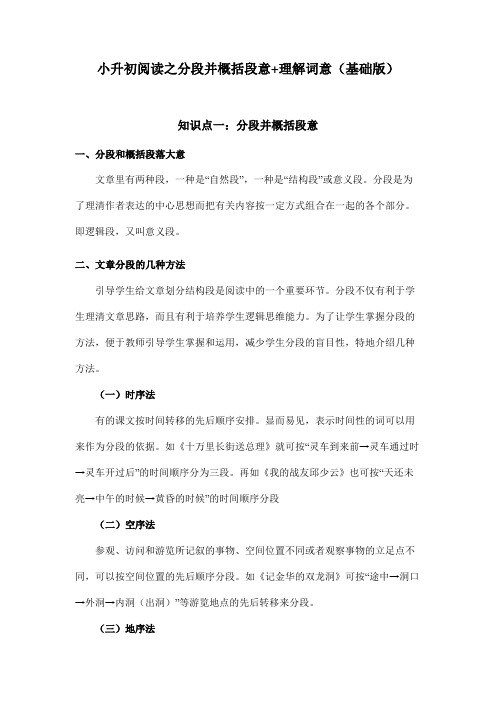
小升初阅读之分段并概括段意+理解词意(基础版)知识点一:分段并概括段意一、分段和概括段落大意文章里有两种段,一种是“自然段”,一种是“结构段”或意义段。
分段是为了理清作者表达的中心思想而把有关内容按一定方式组合在一起的各个部分。
即逻辑段,又叫意义段。
二、文章分段的几种方法引导学生给文章划分结构段是阅读中的一个重要环节。
分段不仅有利于学生理清文章思路,而且有利于培养学生逻辑思维能力。
为了让学生掌握分段的方法,便于教师引导学生掌握和运用,减少学生分段的盲目性,特地介绍几种方法。
(一)时序法有的课文按时间转移的先后顺序安排。
显而易见,表示时间性的词可以用来作为分段的依据。
如《十万里长街送总理》就可按“灵车到来前→灵车通过时→灵车开过后”的时间顺序分为三段。
再如《我的战友邱少云》也可按“天还未亮→中午的时候→黄昏的时候”的时间顺序分段(二)空序法参观、访问和游览所记叙的事物、空间位置不同或者观察事物的立足点不同,可以按空间位置的先后顺序分段。
如《记金华的双龙洞》可按“途中→洞口→外洞→内洞(出洞)”等游览地点的先后转移来分段。
(三)地序法按照事物发生的地点、先后移动的次序组织材料的课文,可以按地点移动的顺序分段。
如《回韶山》可按毛主席回韶山在旧居参观的路线,“上尾场→父母卧室→自己的住房→大弟的房间→晒谷坪”以此作为分段的依据。
(四)事序法完整地记叙一件事或者以客观事物作为线索贯穿全文的课文,可以按事件发展的阶段性来分段。
如《草船借箭》可以按为什么借箭(发生的原因),怎样借箭(发展经过),借箭结果(事件结果)来划分段落。
此外,《跳水》、《飞夺沪定桥》也可按事件发生、发展和结果来划分段落。
(五)事类法有的课文通过写几件事来表达主题,分段时可考虑按不同事情来分段。
如《将相和》可以按“完璧归赵”、“渑池会”、“负荆请罪”三件事来分段。
(六)总分法有的文章是以作者的思路为线索去组织材料的,往往采取“总起——分述——总结”的形式来表述,那么分段时就应按“总——分——总”的思路分段。
2025届高考英语阅读理解之主旨大意题解题策略及真题练习+课件
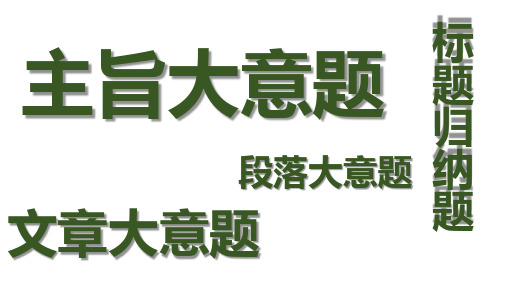
标 题
归
段落大意题 纳
文章大意题
题
主旨大意题(段落大意、文章大意、标题归纳) 旨在考查考生对段落大意或文章中心思想的把握和归纳能力 1.段落大意题 ① What does the author tell us in paragraph...? ② Which of the following can best summarize para....? ③ What is the...paragraph mainly about? 2.文章大意题 ① What’s the main idea/point of the passage? ② Which of the following best states the main idea of the passage? ③ Which of the following statements best expresses the main idea/theme of the passage? 3.标题归纳题 ① Which of the following is the best title of the passage? ② What would be the best title for the passage?
...“I was deeply attracted by the techniques. You can see why this bowl is so highly-valued from the very smooth porcelain body, silky glaze(上 釉 )and special blue coloring, which were never reproduced in later dynasties,” McAteer, an auction specialist, said...
高考阅读之概括段落大意专题训练(精选)

高考阅读之概括段落大意专题训练(精选)专题导入(戏说四大名著)(5分钟)一句话概括四大名著~很好玩~最热门的答案《西游记》论西部开发——唐朝学者出国考察团调研报告《红楼梦》论大观园开发——美女公关公司内幕《水浒传》论梁山开发——108人旅游团的悲惨遭遇《三国演义》论中原开发——三大公司争夺开发内幕最点题的答案《西游记》疯狂的猴子《红楼梦》疯狂的石头《水浒传》杀杀人,喝喝酒《三国演义》大哥,我们动手吧!最雷人的答案《西游记》驴友西域拓展训练的博客《红楼梦》败家子是怎样炼成的《水浒传》兄弟连《三国演义》是金子总会发光——记农村青年孔明最江湖的答案《西游记》俺们天上有人《红楼梦》俺们朝廷有人《水浒传》俺们江湖有人《三国演义》俺们有的是人最心寒的答案《西游记》神仙靠不住《红楼梦》亲戚靠不住《水浒传》老大靠不住《三国演义》战友靠不住最让人想歪的答案《西游记》一个人类和三个动物的故事《红楼梦》一个男人和一群女人的故事《水浒传》一群男人和三个女人的故事《三国演义》三个男人和乱世战争的故事既是戏说,自然是博我们轻松一笑,不过,既然我们能够会心一笑,自然是明白笑点所在,以上玩笑话概括得虽然俗了点,不过倒也把该说的事情说清楚了,至于详细内容,(此处省略N字)哈哈~~~话又说回来,高考题目的归纳要点与概括题,虽然不是戏说,但其精髓和本质都是一样的,用最简短的话说得最全面,最清楚,要不咱们来看看?知识典例(答题步骤)(10分钟)己认为的关键词。
学无定法,只要学生自己能找到适合自己的就是最好的办法。
)强化练习(牛刀小试)(22分钟)【例一】随着资源性产品市场竞争的加剧,发达国家为了保护本国资源型产业,不断祭起“反倾销”、“反补贴”、“知识产权保护”和“技术壁垒”等法宝,将资源性产品的国际贸易战提高到一个新水平。
例如,最近美国为了保护本国的钢铁工业,制定了2001年钢铁保障措施方案,不惜与全球钢铁工业开战。
近年来,全球每年均发生近千件“反倾销”案件,其中相当一部分是针对资源性产品的。
考点5 阅读理解之段落大意(原卷版)

考点5 阅读理解之段落大意Part 1 题型详解:主旨大意之段落大意考点是高考中的必考点。
这些设置题目的段落或引出话题或承上启下或总结全文。
命题者的意图是明确的,他们着眼于文章中起重要作用的段落进而设题。
预测在2024高考中,段落大意题会继续在高考阅读理解中呈现。
Part 2 常见设问方式:1.What is this paragraph mainly about?2.The main idea of paragraph 2 and 3 is....3.What’s the main idea of paragraph...?Part 3 解题方法指导:1.了解篇章结构,段落大意题目仍然是概括性的题目,段落大意应围绕主题发展。
2. 关注段首,段尾,段落中有关转折、递进的句子。
Part 4 真题检测2023年全国乙卷英语真题If you want to tell the history of the whole world, a history that does not privilege one part of humanity, you cannot do it through texts alone, because only some of the world has ever had texts, while most of the world, for most of the time, has not. Writing is one of humanity’s later achievements, and until fairly recently even many literate (有文字的) societies recorded their concerns not only in writing but in things.Ideally a history would bring together texts and objects, and some chapters of this book are able to do just that, but in many cases we simply can’t. The clearest example of this between literate and non-literate history is perhaps the first conflict, at Botany Bay, between Captain Cook’s voyage and the Australian Aboriginals. From the English side, we have scientific reports and the captain’s record of that terrible day. From the Australian side, we have only a wooden shield (盾) dropped by a man in flight after his first experience of gunshot. If we want to reconstruct what was actually going on that day, the shield must be questioned and interpreted as deeply and strictly as the written reports.In addition to the problem of miscomprehension from both sides, there are victories accidentally or deliberately twisted, especially when only the victors know how to write. Those who are on the losing side often have only their things to tell their stories. The Caribbean Taino, the Australian Aboriginals, the African people of Benin and the Incas, all of whom appear in this book, can speak to us now of their past achievements most powerfully through the objects they made: a history told through things gives them back a voice. When we consider contact (联系) between literate and non-literate societies such as these, all our first-hand accounts are necessarily twisted, only one half of a dialogue. If we are to find the other half of that conversation, we have to read not just the texts, but the objects.1.What is the first paragraph mainly about?A.How past events should be presented.B.What humanity is concerned about.C.Whether facts speak louder than words.D.Why written language is reliable.2023年新课标全国Ⅰ卷英语真题On March 7, 1907, the English statistician Francis Galton published a paper which illustrated what has come to be known as the “wisdom of crowds” effect. The experiment of estimation he conducted showed that in some cases, the average of a large number of independent estimates could be quite accurate.This effect capitalizes on the fact that when people make errors, those errors aren’t always the same. Some people will tend to overestimate, and some to underestimate. When enough of these errors are averaged together, they cancel each other out, resulting in a more accurate estimate. If people are similar and tend to make the same errors, then their errors won’t cancel each other out. In more technical terms, the wisdom of crowds requires that people’s estimates be independent. If for whatever reasons, people’s errors become correlated or dependent, the accuracy of the estimate will go down.But a new study led by Joaquin Navajas offered an interesting twist (转折) on this classic phenomenon. The key finding of the study was that when crowds were further divided into smaller groups that were allowed to have a discussion, the averages from these groups were more accurate than those from an equal number of independent individuals. For instance, the average obtained from the estimates of four discussion groups of five was significantly more accurate than the average obtained from 20 independent individuals.In a follow-up study with 100 university students, the researchers tried to get a better sense of what the group members actually did in their discussion. Did they tend to go with those most confident about their estimates? Did they follow those least willing to change their minds? This happened some of the time, but it wasn’t the dominant response. Most frequently, the groups reported that they “shared arguments and reasoned together”. Somehow, these arguments and reasoning resulted in a global reduction in error. Although the studies led by Navajas have limitations and many questions remain, the potential implications for group discussion and decision-making are enormous.5.What is paragraph 2 of the text mainly about?A.The methods of estimation.B.The underlying logic of the effect.C.The causes of people’s errors.D.The design of Galton’s experiment.2022年新高考全国Ⅰ卷英语真题Human speech contains more than 2,000 different sounds, from the common “m” and “a” to the rare clicks of some southern African languages. But why are certain sounds more common than others? A ground-breaking, five-year study shows that diet-related changes in human bite led to new speech sounds that are now found in half the world’s languages.More than 30 years ago, the scholar Charles Hockett noted that speech sounds called labiodentals, such as “f” and “v”, were more common in the languages of societies that ate softer foods. Now a team of researchers led by Damián Blasi at the University of Zurich, Switzerland, has found how and why this trend arose.They discovered that the upper and lower front teeth of ancient human adults were aligned (对齐), making ithard to produce labiodentals, which are formed by touching the lower lip to the upper teeth. Later, our jaws changed to an overbite structure (结构), making it easier to produce such sounds.The team showed that this change in bite was connected with the development of agriculture in the Neolithic period. Food became easier to chew at this point. The jawbone didn’t have to do as much work and so didn’t grow to be so large.Analyses of a language database also confirmed that there was a global change in the sound of world languages after the Neolithic age, with the use of “f” and “v” increasing remarkably during the last few thousand years. These sounds are still not found in the languages of many hunter-gatherer people today.This research overturns the popular view that all human speech sounds were present when human beings evolved around 300,000 years ago. “The set of speech sounds we use has not necessarily remained stable since the appearance of human beings, but rather the huge variety of speech sounds that we find today is the product of a complex interplay of things like biological change and cultural evolution,” said Steven Moran, a member of the research team.11.What is paragraph 5 mainly about?A.Supporting evidence for the research results.B.Potential application of the research findings.C.A further explanation of the research methods.D.A reasonable doubt about the research process.2022年全国甲卷英语真题Sometime in the early 1960s, a significant thing happened in Sydney, Australia. The city discovered its harbor. Then, one after another, Sydney discovered lots of things that were just sort of there — broad parks, superb beaches, and a culturally diverse population. But it is the harbor that makes the city.Andrew Reynolds, a cheerful fellow in his early 30s, pilots Sydney ferryboats for a living. I spent the whole morning shuttling back and forth across the harbor. After our third run Andrew shut down the engine, and we went our separate ways — he for a lunch break, I to explore the city.“I’ll miss these old boats,” he said as we parted.“How do you mean?” I asked.“Oh, they’re replacing them with catamarans. Catamarans are faster, but they’re not so elegant, and they’re not fun to pilot. But that’s progress, I guess.”Everywhere in Sydney these days, change and progress are the watchwords (口号), and traditions are increasingly rare. Shirley Fitzgerald, the city’s official historian, told me that in its rush to modernity in the 1970s, Sydney swept aside much of its past, including many of its finest buildings. “Sydney is confused about itself,” she said. “We can’t seem to make up our minds whether we want a modern city or a traditional one. It’s a conflict that we aren’t getting any better at resolving (解决).”On the other hand, being young and old at the same time has its attractions. I considered this when I met a thoughtful young businessman named Anthony. “Many people say that we lack culture in this country,” he told me. “What people forget is that the Italians, when they came to Australia, brought 2000 years of their culture, theGreeks some 3000 years, and the Chinese more still. We’ve got a foundation built on ancient cultures but with a drive and dynamism of a young country. It’s a pretty hard combination to beat.”He is right, but I can’t help wishing they would keep those old ferries.13.What is the first paragraph mainly about?A.Sydney’s striking architecture.B.The cultural diversity of Sydney.C.The key to Sydney’s development.D.Sydney’s tourist attractions in the 1960s.2021年北京市英语高考真题Early fifth-century philosopher St.Augustine famously wrote that he knew what time was unless someone asked him.Albert Einstein added another wrinkle when he theorized that time varies depending on where you measure it.Today's state-of-the-art atomic(原子的)clocks have proven Einstein right.Even advanced physics can't decisively tell us what time is, because the answer depends on the question you're asking.Forget about time as an absolute.What if,instead of considering time in terms of astronomy,we related time to ecology?What if we allowed environmental conditions to set the tempo(节奏)of human life?We're increasingly aware of the fact that we can't control Earth systems with engineering alone,and realizing that we need to moderate (调节)our actions if we hope to live in balance.What if our definition of time reflected that?Recently,I conceptualized a new approach to timekeeping that's connected to circumstances on our planet,conditions that might change as a result of global warming.We're now building a clock at the Anchorage Museum that reflects the total flow of several major Alaskan rivers,which are sensitive to local and global environmental changes.We've programmed it to match an atomic clock if the waterways continue to flow at their present rate.If the rivers run faster in the future on average,the clock will get ahead of standard time.If they run slower,you'll see the opposite effect.The clock registers both short-term irregularities and long-term trends in river dynamics.It's a sort of observatory that reveals how the rivers are behaving from their own temporal frame(时间框架),and allows us to witness those changes on our smartwatches or phones.Anyone who opts to go on Alaska Mean River Time will live in harmony with the planet.Anyone who considers river time in relation to atomic time will encounter a major imbalance and may be motivated to counteract it by consuming less fuel or supporting greener policies.Even if this method of timekeeping is novel in its particulars,early agricultural societies also connected time to natural phenomena.In pre-Classical Greece,for instance,people“corrected”official calendars by shifting dates forward or backward to reflect the change of season.Temporal connection to the environment was vital to their survival.Likewise,river time and other timekeeping systems we're developing may encourage environmental awareness.When St.Augustine admitted his inability to define time,he highlighted one of time 's most noticeable qualities:Time becomes meaningful only in a defined context.Any timekeeping system is valid,and each is as praiseworthy as its purpose.17.What is the main idea of Paragraph 1?A.Timekeeping is increasingly related to nature.B.Everyone can define time on their own terms.C.The qualities of time vary with how you measure it.D.Time is a major concern of philosophers and scientists.2021年浙江卷英语真题(7月)If you ever get the impression that your dog can “tell” whether you look content or annoyed, you may be onto something. Dogs may indeed be able to distinguish between happy and angry human faces, according to a new study.Researchers trained a group of 11 dogs to distinguish between images (图像) of the same person making either a happy or an angry face. During the training stage, each dog was shown only the upper half or the lower half of the person’s face. The researchers then tested the dogs’ ability to distinguish between human facial expressions by showing them the other half of the person’s face on images totally different from the ones used in training. The researchers found that the dogs were able to pick the angry or happy face by touching a picture of it with their noses more often than one would expect by random chance.The study showed the animals had figured out how to apply what they learned about human faces during training to new faces in the testing stage. “We can rule out that the dogs simply distinguish between the pictures based on a simple cue, such as the sight of teeth,” said study author Corsin Muller. “Instead, our results suggest that the successful dogs realized that a smiling mouth means the same thing as smiling eyes, and the same rule applies to an angry mouth having the same meaning as angry eyes.”“With our study, we think we can now confidently conclude that at least some dogs can distinguish human facial expressions,” Muller told Live Science.At this point, it is not clear why dogs seem to be equipped with the ability to recognize different facial expressions in humans. “To us, the most likely explanation appears to be that the basis lies in their living with humans, which gives them a lot of exposure to human facial expressions, and this exposure has provided them with many chances to learn to distinguish between them,” Muller said.23.What is the last paragraph mainly about?A.A suggestion for future studies.B.A possible reason for the study findings.C.A major limitation of the study D.An explanation of the research method.2021年全国乙卷英语真题When almost everyone has a mobile phone, why are more than half of Australian homes still paying for a landline (座机)?These days you’d be hard pressed to find anyone in Australia over the age of 15 who doesn’t own a mobile phone. In fact plenty of younger kids have one in their pocket. Practically everyone can make and receive calls anywhere, anytime.Still, 55 percent of Australians have a landline phone at home and only just over a quarter (29%) rely only on their smartphones according to a survey (调查). Of those Australians who still have a landline, a third concede that it’s not really necessary and they’re keeping it as a security blanket — 19 percent say they never use it while a further 13 percent keep it in case of emergencies. I think my home falls into that category.More than half of Australian homes are still choosing to stick with their home phone. Age is naturally a factor (因素)— only 58 percent of Generation Ys still use landlines now and then, compared to 84 percent of Baby Boomers who’ve perhaps had the same home number for 50 years. Age isn’t the only factor; I’d say it’s also to do with the makeup of your household.Generation Xers with young families, like my wife and I, can still find it convenient to have a home phone rather than providing a mobile phone for every family member. That said, to be honest the only people who ever ring our home phone are our Baby Boomers parents, to the point where we play a game and guess who is calling before we pick up the phone (using Caller ID would take the fun out of it).How attached are you to your landline? How long until they go the way of gas street lamps and morning milk deliveries?24.What does paragraph 2 mainly tell us about mobile phones?A.Their target users.B.Their wide popularity.C.Their major functions.D.Their complex design.Part 5 模拟练习2024届河南省信阳市浉河区信阳高级中学高三上学期一模英语试题Cities are difficult to navigate (导航) at the best of times, but for people with disabilities they can be like courses with hurdles and bring inconvenience to disabled people.A UK national travel survey found that adults with mobility difficulties took 39% fewer trips than those with no disability in 2017. Yet that could change as devices and cities grow smarter. Assistive tech is playing a big role in the transformation. The global value of the industry is expected to increase from $14 billion in 2015 to $30.8 billion in 2024, according to Zion Market Research.One of the things that could transform lives is a smart walking stick designed by engineers from Young Guru Academy (YGA) in Turkey. The WeWalk stick has a sensor that detects hurdles above chest level and uses vibrations (振动) to warn the user. It can be paired with a smartphone to help navigation, and is connected with a voice assistant and Google Maps.Ceylan, who has been blind since birth, says that connecting the stick to the Internet of Things and smart city solutions makes it user-friendly. “As a blind person, when I am at the Metro station I don’t know which is my exit ...I don’t know which bus is approaching ... which stores are around me. That kind of information can be provided with the WeWalk,” he says.“The smart walking stick is really an exciting initiative that will make a huge difference to some people,” says Anna Lawson, the director of the Center for Disability Studies at Leeds University in the United Kingdom. “But they are very expensive ... they’re not going to be available to the vast majority of disabled people,” she added.Bryan Matthews, a lecturer at the Institute for Transport Studies at the University of Leeds, shares theconcerns about cost. He says there should also be a focus on inclusive design, and anything that helps people navigate their environment is positive.29.What does paragraph 3 mainly talk about?A.The working principles of the WeWalk stick.B.The introduction of the WeWalk stick inventors.C.The transformation caused by the WeWalk stick.D.The benefits brought about by the WeWalk stick.2023届安徽省、云南省、吉林省、黑龙江省高三下学期2月适应性测试英语试题For years, David James, who studies insects at Washington State University, had wanted to examine the migration (迁徙)patterns of West Coast monarch butterflies (黑脉金斑蝶). The route the butterflies travel has been hardly known because the populations are too small to follow. For every 200 monarchs tagged (打标签)by a researcher, only one is usually recovered at the end of its trip, James says, and finding even 200 in the wild to tag is unlikely. Knowing the route is vital to conservation efforts, but James had no way to figure it out- until he got a phone call from Washington State Penitentiary in Walla Walla.The prison was looking for new activities to improve the mental health of those serving long-term sentences. So James began working with prisoners to raise monarchs through the whole process of their transformation. The adult insects were then tagged and released from the prison. Over five years, nearly 10, 000 monarchs flew from the facility. Elsewhere in Washington, Oregon and Idaho, researchers released another few thousand.The tags included email addresses, and soon after the first butterflies took off, James started receiving messages from people who had spotted them. The butterflies, the reports confirmed, wintered in coastal California. Twelve of them landed at Lighthouse Field State Beach in Santa Cruz. Several more headed to Bolinas and Morro Bay.The work helps researchers identify ideal places to plant milkweed and other vegetation that are important to the life cycle of West Coast monarch butterflies. It also brought out the gentler side of some of the prisoners. “They were very worried that they were going to harm the butterflies, ”James says. Watching the monarch change their form also touched the men. “This butterfly changed, ” James recalls prisoners telling him, “and maybe we can too. ”35.What is the last paragraph mainly about?A.The impact of the research.B.The findings of James’ study.C.The release of the prisoners.D.The life cycle of the butterflies.2023届广东省深圳市高三年级第一次调研考试英语试题From cottages surrounded by impressive gardens to days spent exploring sandy beaches and deep woods filled with wildlife, in My Family and Other Animals, English writer Gerald Durrell provided a vivid account of hisfamily’s time on the Greek island of Corfu in the 1930s.Come for the arresting descriptions of Corfu landscapes and stay for Durrell’s laugh-out-loud tales of his unusual family. This book, Durrell wrote humorously in the introduction, “was intended to be a nostalgic (怀旧的) account of natural history, but in the first few pages, I made the mistake of introducing my family. ”Durrell, later known for his zoo keeping and the preservation of wildlife, was just a child during his family’s five-year stay in Corfu. He is 10-year-old Gerry in the book — curious, passionate about animals and a detailed storyteller of his strange family: his imaginative elder brother Larry with his literary ambitions, lovestruck sister Margo, sporty brother Leslie and his ever-calm, loving mother.Durrell’s attention to detail is what makes the book so winning, with every sight, sound and smell of the island brought to life. One minute you’ll be laughing as Larry’s clever literary friends walk down to the daffodil-yellow cottage, the next you’ll be catching your breath as Durrell describes swimming at night in the Ionian Sea: “Lying on my back in the silky water, staring at the sky, only moving my hands and feet slightly, I was looking at the Milky Way stretching like a silk scarf across the sky and wondering how many stars it contained. ”My Family and Other Animals is quite difficult to classify, being one part travel, one part autobiography, one part natural history, and one part comedy, with a thread of descriptive language running throughout that sometimes raises it nearly to poetry.As a real delight to read, it’s the perfect literary escapism for any adult or older teenager who is currently walking down a tough road in life.38.What are paragraph 4 and 5 mainly about?A.The book’s writing feature.B.Durrell’s rich imagination.C.Some interesting plots of the book.D.Some vivid descriptions of the island.2023届广东省广州市普通高中毕业班综合测试(一)英语试题Beavers(海狸), like humans, change their surroundings to fit their needs. Known as nature’s engineers, they tear trees down to build homes to live in and dams to raise water levels for protection from enemies. Dams also slow water’s flow while blocking sediment(沉积物)that would otherwise flow downstream. The resulting wetlands often attract wildlife diversity where none had existed. There are challenges, though. Beaver dams sometimes cause flooding, and most people prefer trees alive and upright.Communities face a delicate balancing act, learning to coexist with beavers. Last winter, many people enjoying Winston Path became beaver fans as one furry family transformed Swallow Pond into an oasis for birds, frogs, turtles and deer.Yet such activity caused concern. As beavers worked, they raised water levels about five feet. The increased depth allows beavers to survive underwater if the pond ices over. But county officials were concerned about how higher water would affect the soil bank supporting Winston Path.To find a good balance between protecting the path and the beavers, the county introduced a“ beaver baffle”—a pond leveler.Beavers often rush to fill holes in their dams.Baffles stabilize water levels by creating a hidden exit for high water to escape through the dam, unnoticed by the beavers.People love the beavers but they also love the mature trees. Recently, Catherine Jones,18, organized a tree-caging event — putting wire cloth around large tree trunks to discourage beavers from biting them. It also protects people from injury due to random trees falling.“We cover the trees we don’t want them to eat, while planting periodically others they like,“said Jones.“We need-to learn to give up a little of our wants to share the Earth’s resources.”Swallow Pond’s 2023 project will restore proper water depth and improve wildlife habitat without creating problems for the path. The balancing act continues.40.What is the first paragraph mainly about?A.Where beavers’ favorite surroundings are.B.What effects beavers have on their habitat.C.Why beavers are called nature’s engineers.D.How beavers help attract wildlife diversity.2023届江苏省苏锡常镇四市高三下学期3月教学情况调研(一)英语试题Los Angeles native Randall Bartlett sat under the rooftop of a traditional Chinese scholar’s studio, occasionally turning a page of his book. The scene was in the reopened Liu Fang Yuan garden at the Huntington Library, Art Museum and Botanical Gardens. For him, the garden brings to life the Chinese philosophies he learned from books.Phillip E. Bloom, director of the Center for East Asian Garden Studies, said the idea for Liu Fang Yuan goes back to the 1980s with the initial aim of creating a collection of Chinese plants, but after research, they realized plants alone were not sufficient to demonstrate the essence of a Chinese garden. Eventually, it was decided to model a garden on 16th and 17th century scholarly retreats(隐居处)in Suzhou.The decision was made partly due to the fame of Suzhou classical gardens, but also because similarities were found between the Huntington and Suzhou gardens. Bloom said that Henry Huntington, founder of the Huntington Library, was a successful US businessman who used his fortune to collect rare books, artworks and to create gardens. “Many Suzhou gardens were also created by rich people who tried to pursue a scholarly lifestyle,” he added.To preserve the character of the Suzhou gardens, the Huntington Library sought help from Suzhou, giving rise to collaboration between US and Chinese architects, contractors and designers. In all stages of construction, artisans(工匠)from Suzhou came to work on details of the venue.After three years of expansion from 2018 to 2020, Liu Fang Y uan reopened to the public with 4.6 hectares of new landscape, making it one of the largest classical-style Chinese gardens in the world. The additions include courtyards displaying penjing, a scholar’s studio, a pavilion(亭子)situated at the garden’s highest point, etc.Now, it is meaningful to see how people from local communities interact with the garden. “A lot of volunteers come to different lectures and exhibitions about Chinese culture hat we hold regularly,” Bloom said. By exposingits visitors to arts and literature, Liu Fang uan goes beyond international boundaries and bridges the cultural gaps between the two ountries.45.What is paragraph 3 mainly about?A.The introduction to the founder.B.The fame of Suzhou classical gardens.C.The features of a scholarly lifestyle.D.The reasons for modeling a Suzhou garden.。
如何概括段落大意和中心思想

如何概括段落大意段落大意是指段的主要意思。
正确地概括段落大意,有助于我们掌握文章的主要内容和深入理解文章的中心思想。
一般地说,一个自然段就是一段的,要抓住重点句来归纳段意;几个自然段合起来成一段的,要舍弃次要内容,抓住主要内容。
归纳段落大意的要求有八个字,就是:明确、完整、简要、通顺。
“明确”是指让别人一看就明白这段主要写什么。
“完整”是指该概括的要点不能遗漏。
“简要”是指语句要简洁,做到言简意明。
“通顺”是指语句要通顺。
下面我们来介绍几种概括段意的具体方法,用简练的语言概括出段落大意。
1、摘句归纳法。
就是从段落中摘录能反映全段主要内容的现成句子作为段意。
这些句子,一般可以从总分结构的段落、有明显中心句的段落和段内有过渡句的段落中选出。
例如《卢沟桥的狮子》一文的第二段:这些狮子真有意思。
它们有大有小。
大的有几十厘米,小的只有几厘米,甚至连鼻子眼睛都看不清。
它们的形状各不相同,有的蹲坐在石柱上,好像朝着远方长吼;有的低着头,好像专心听桥下的流水声;有的小狮子偎依在母狮子的怀里,好像正在熟睡;有的小狮子藏到大狮子的身后,好像在做游戏;还有的小狮子大概太淘气了,被大狮子用爪子按在地上……卢沟桥的狮子大小不一,形态各异,真是很难数清楚。
但是文物工作者早就数清了,总共485只。
“卢沟桥的狮子大小不一,形态各异。
”这句话是这一段的小结句,总结了这段话的主要内容,因此,可作为这一段的段意。
又如《詹天佑》一文的第一段:詹天佑是我国杰出的爱国工程师。
从北京到张家口这一段铁路,就是在他的主持下修筑成功的。
这是第一条完全由我国的工程技术人员设计施工的铁路干线。
第一句话:“詹天佑是我国杰出的爱国工程师。
”是这段的中心句,点明了这段要介绍的主要内容,因而可作为这一段的段意。
2、合并归纳法。
有时,一个段落中的几层意思是并列的,很难分辨主次,概括段意时,就必须把几个并列的意思合并起来进行概括。
例如:鲸的身子这么大,它们吃什么呢?须鲸主要吃虾和小鱼。
概括段落大意
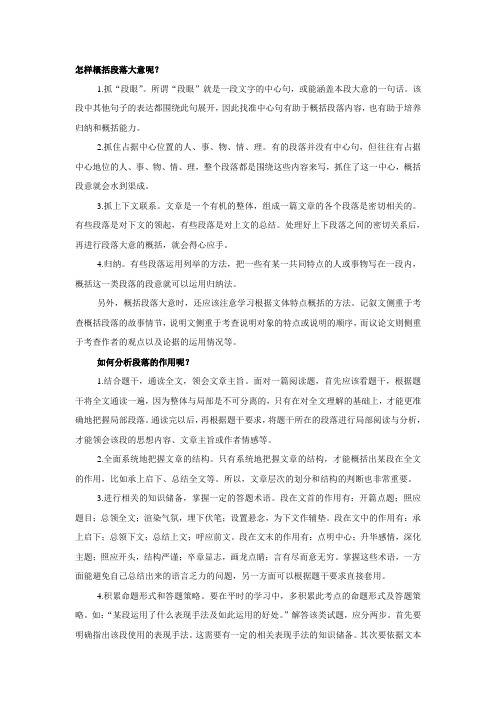
怎样概括段落大意呢?1.抓“段眼”。
所谓“段眼”就是一段文字的中心句,或能涵盖本段大意的一句话。
该段中其他句子的表达都围绕此句展开,因此找准中心句有助于概括段落内容,也有助于培养归纳和概括能力。
2.抓住占据中心位置的人、事、物、情、理。
有的段落并没有中心句,但往往有占据中心地位的人、事、物、情、理,整个段落都是围绕这些内容来写,抓住了这一中心,概括段意就会水到渠成。
3.抓上下文联系。
文章是一个有机的整体,组成一篇文章的各个段落是密切相关的。
有些段落是对下文的领起,有些段落是对上文的总结。
处理好上下段落之间的密切关系后,再进行段落大意的概括,就会得心应手。
4.归纳。
有些段落运用列举的方法,把一些有某一共同特点的人或事物写在一段内,概括这一类段落的段意就可以运用归纳法。
另外,概括段落大意时,还应该注意学习根据文体特点概括的方法。
记叙文侧重于考查概括段落的故事情节,说明文侧重于考查说明对象的特点或说明的顺序,而议论文则侧重于考查作者的观点以及论据的运用情况等。
如何分析段落的作用呢?1.结合题干,通读全文,领会文章主旨。
面对一篇阅读题,首先应该看题干,根据题干将全文通读一遍,因为整体与局部是不可分离的,只有在对全文理解的基础上,才能更准确地把握局部段落。
通读完以后,再根据题干要求,将题干所在的段落进行局部阅读与分析,才能领会该段的思想内容、文章主旨或作者情感等。
2.全面系统地把握文章的结构。
只有系统地把握文章的结构,才能概括出某段在全文的作用,比如承上启下、总结全文等。
所以,文章层次的划分和结构的判断也非常重要。
3.进行相关的知识储备,掌握一定的答题术语。
段在文首的作用有:开篇点题;照应题目;总领全文;渲染气氛,埋下伏笔;设置悬念,为下文作辅垫。
段在文中的作用有:承上启下;总领下文;总结上文;呼应前文。
段在文末的作用有:点明中心;升华感情,深化主题;照应开头,结构严谨;卒章显志,画龙点睛;言有尽而意无穷。
(完整版)四年级语文阅读理解之概括段落大意(有答案)
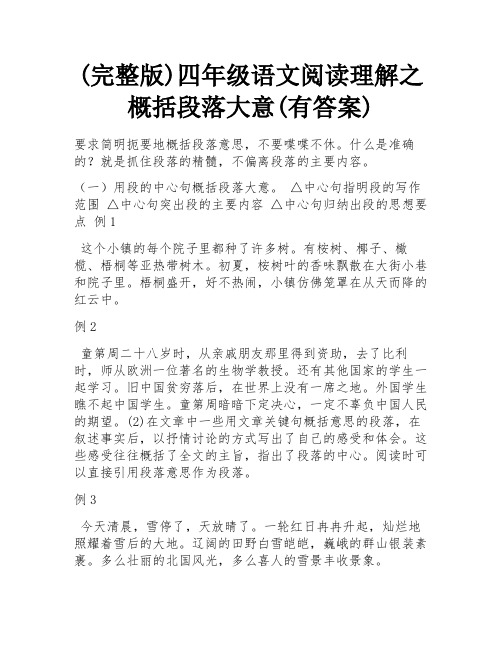
(完整版)四年级语文阅读理解之概括段落大意(有答案)要求简明扼要地概括段落意思,不要喋喋不休。
什么是准确的?就是抓住段落的精髓,不偏离段落的主要内容。
(一)用段的中心句概括段落大意。
△中心句指明段的写作范围△中心句突出段的主要内容△中心句归纳出段的思想要点例1这个小镇的每个院子里都种了许多树。
有桉树、椰子、橄榄、梧桐等亚热带树木。
初夏,桉树叶的香味飘散在大街小巷和院子里。
梧桐盛开,好不热闹,小镇仿佛笼罩在从天而降的红云中。
例2童第周二十八岁时,从亲戚朋友那里得到资助,去了比利时,师从欧洲一位著名的生物学教授。
还有其他国家的学生一起学习。
旧中国贫穷落后,在世界上没有一席之地。
外国学生瞧不起中国学生。
童第周暗暗下定决心,一定不辜负中国人民的期望。
(2)在文章中一些用文章关键句概括意思的段落,在叙述事实后,以抒情讨论的方式写出了自己的感受和体会。
这些感受往往概括了全文的主旨,指出了段落的中心。
阅读时可以直接引用段落意思作为段落。
例3今天清晨,雪停了,天放晴了。
一轮红日冉冉升起,灿烂地照耀着雪后的大地。
辽阔的田野白雪皑皑,巍峨的群山银装素裹。
多么壮丽的北国风光,多么喜人的雪景丰收景象。
(三)用自己的语言概括段意如果一个段落中没有直接表达中心的句子,就需要用自己的语言来表达。
步骤:1.这一段有几个句子。
2.每个句子是什么意思?3.可以分为几层。
4.每一层的内容是什么?5.总结每一层的意思,然后总结段落的主要意思。
例4那一天,天还没有亮,我们连悄悄地摸进“三九一”高地下面的山坳,潜伏在一条比较隐蔽的山沟里。
太阳渐渐地爬上山头。
我发现前面六十多米就是敌人的前沿阵地,不但可以看见铁丝网和胸墙,还可以看见地堡和火力点,甚至连敌人的讲话都听得见。
敌人居高临下,当然更容易看见我们。
我们趴在地上必须纹丝不动,咳嗽一声或蜷一下腿,都可能被敌人发觉。
他们身上披着厚厚的茅草作为伪装,猛一看去,很难发现他们。
我又看了看伏在身边不远的邱少云。
概括段落大意的方法

概括段落大意的方法概括段落大意是阅读理解中非常重要的一个技巧,可以帮助读者更快、更准确地理解文章的含义。
以下是几种概括段落大意的方法:1.寻找主题句。
很多段落都会在开头或结尾明确阐述一个中心思想,或者提出一个问题来引出接下来的讨论。
在阅读时,我们可以先找到这个主题句,然后对其进行概括,从而得出整个段落的大意。
2.理清逻辑关系。
段落中的句子不仅仅是孤立存在的,它们之间还有着内在的逻辑联系。
因此,我们在阅读时可以通过理清这些逻辑关系,来概括段落的大意。
例如,我们可以找出段落中的转折点、因果关系、并列关系等等。
3.找出关键词。
段落中通常会有一些关键词或术语,它们是这段文章的重点所在。
我们可以将这些关键词提取出来,然后归纳总结,从而概括出整个段落的主旨。
需要注意的是,这些关键词可能并不是只出现在一个句子中,而是分散在整个段落中。
4.归纳总结。
在理解了整个段落后,我们可以通过自己的语言进行总结概括。
这个方法需要一定的文字表达能力和语感,但是如果掌握得好,可以很好地帮助我们更深入地理解文章内容。
总之,概括段落大意需要逐句逐字仔细阅读,理清逻辑关系,找出段落中的重点和关键词,并结合自己的理解进行总结概括。
以下是一个例子:段落内容:在当今社会中,面对越来越多的压力和竞争,很多人都感到紧张和不安。
为了缓解这种情绪,有人选择了运动、旅游等健康的方式来排解压力,但是也有一些人会选择吸烟、喝酒等不健康的方式来发泄情绪。
这种行为不仅不能解决问题,反而会对身体和心理造成更大的危害。
概括方法:通过寻找主题句,我们可以得出这个段落的主旨是关于人们面临压力时会有不同的应对方式;通过理清逻辑关系,我们可以发现段落中有两种不同的应对方式,即健康的方式和不健康的方式;通过找出关键词,我们可以提取出“压力”,“运动”和“吸烟、喝酒”等词汇,并归纳出这个段落的大意是告诫读者应该采用健康的方式来缓解压力。
最后,我们可以自己总结概括这个段落的主旨是:在面对压力时应该选择健康的方式来排解情绪,而不是通过不健康的方式来造成更多的伤害。
小学语文概括段落大意的方法

小学语文概括段落大意的方法(经典版)编制人:__________________审核人:__________________审批人:__________________编制单位:__________________编制时间:____年____月____日序言下载提示:该文档是本店铺精心编制而成的,希望大家下载后,能够帮助大家解决实际问题。
文档下载后可定制修改,请根据实际需要进行调整和使用,谢谢!并且,本店铺为大家提供各种类型的经典范文,如演讲稿、总结报告、合同协议、方案大全、工作计划、学习计划、条据书信、致辞讲话、教学资料、作文大全、其他范文等等,想了解不同范文格式和写法,敬请关注!Download tips: This document is carefully compiled by this editor. I hope that after you download it, it can help you solve practical problems. The document can be customized and modified after downloading, please adjust and use it according to actual needs, thank you!In addition, this shop provides you with various types of classic sample essays, such as speech drafts, summary reports, contract agreements, project plans, work plans, study plans, letter letters, speeches, teaching materials, essays, other sample essays, etc. Want to know the format and writing of different sample essays, so stay tuned!小学语文概括段落大意的方法理解文章的写作目的的前提,也是培养自己分析概括能力的重要训练。
【小升初语文讲义】第14讲:阅读之分段并概括段意+词意理解(部编版,含例题,答案)

小升初阅读之分段并概括段意+理解词意(基础版)知识点一:分段并概括段意一、分段和概括段落大意文章里有两种段,一种是“自然段”,一种是“结构段”或意义段。
分段是为了理清作者表达的中心思想而把有关内容按一定方式组合在一起的各个部分。
即逻辑段,又叫意义段。
二、文章分段的几种方法引导学生给文章划分结构段是阅读中的一个重要环节。
分段不仅有利于学生理清文章思路,而且有利于培养学生逻辑思维能力。
为了让学生掌握分段的方法,便于教师引导学生掌握和运用,减少学生分段的盲目性,特地介绍几种方法。
(一)时序法有的课文按时间转移的先后顺序安排。
显而易见,表示时间性的词可以用来作为分段的依据。
如《十万里长街送总理》就可按“灵车到来前→灵车通过时→灵车开过后”的时间顺序分为三段。
再如《我的战友邱少云》也可按“天还未亮→中午的时候→黄昏的时候”的时间顺序分段(二)空序法参观、访问和游览所记叙的事物、空间位置不同或者观察事物的立足点不同,可以按空间位置的先后顺序分段。
如《记金华的双龙洞》可按“途中→洞口→外洞→内洞(出洞)”等游览地点的先后转移来分段。
(三)地序法按照事物发生的地点、先后移动的次序组织材料的课文,可以按地点移动的顺序分段。
如《回韶山》可按毛主席回韶山在旧居参观的路线,“上尾场→父母卧室→自己的住房→大弟的房间→晒谷坪”以此作为分段的依据。
(四)事序法完整地记叙一件事或者以客观事物作为线索贯穿全文的课文,可以按事件发展的阶段性来分段。
如《草船借箭》可以按为什么借箭(发生的原因),怎样借箭(发展经过),借箭结果(事件结果)来划分段落。
此外,《跳水》、《飞夺沪定桥》也可按事件发生、发展和结果来划分段落。
(五)事类法有的课文通过写几件事来表达主题,分段时可考虑按不同事情来分段。
如《将相和》可以按“完璧归赵”、“渑池会”、“负荆请罪”三件事来分段。
(六)总分法有的文章是以作者的思路为线索去组织材料的,往往采取“总起——分述——总结”的形式来表述,那么分段时就应按“总——分——总”的思路分段。
概括文章段落大意的方法
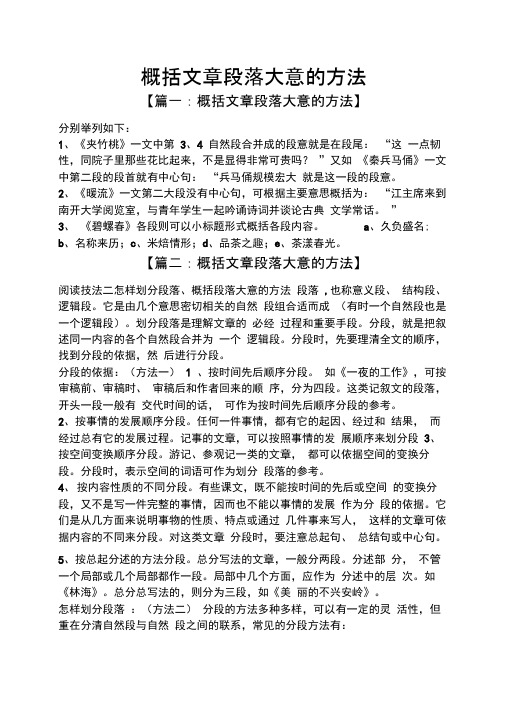
概括文章段落大意的方法【篇一:概括文章段落大意的方法】分别举列如下:1、《夹竹桃》一文中第3、4 自然段合并成的段意就是在段尾:“这一点韧性,同院子里那些花比起来,不是显得非常可贵吗?”又如《秦兵马俑》一文中第二段的段首就有中心句:“兵马俑规模宏大就是这一段的段意。
2、《暖流》一文第二大段没有中心句,可根据主要意思概括为:“江主席来到南开大学阅览室,与青年学生一起吟诵诗词并谈论古典文学常话。
”3、《碧螺春》各段则可以小标题形式概括各段内容。
a、久负盛名;b、名称来历;c、米焙情形;d、品茶之趣;e、茶漾春光。
【篇二:概括文章段落大意的方法】阅读技法二怎样划分段落、概括段落大意的方法段落,也称意义段、结构段、逻辑段。
它是由几个意思密切相关的自然段组合适而成(有时一个自然段也是一个逻辑段)。
划分段落是理解文章的必经过程和重要手段。
分段,就是把叙述同一内容的各个自然段合并为一个逻辑段。
分段时,先要理清全文的顺序,找到分段的依据,然后进行分段。
分段的依据:(方法一) 1 、按时间先后顺序分段。
如《一夜的工作》,可按审稿前、审稿时、审稿后和作者回来的顺序,分为四段。
这类记叙文的段落,开头一段一般有交代时间的话,可作为按时间先后顺序分段的参考。
2、按事情的发展顺序分段。
任何一件事情,都有它的起因、经过和结果,而经过总有它的发展过程。
记事的文章,可以按照事情的发展顺序来划分段3、按空间变换顺序分段。
游记、参观记一类的文章,都可以依据空间的变换分段。
分段时,表示空间的词语可作为划分段落的参考。
4、按内容性质的不同分段。
有些课文,既不能按时间的先后或空间的变换分段,又不是写一件完整的事情,因而也不能以事情的发展作为分段的依据。
它们是从几方面来说明事物的性质、特点或通过几件事来写人,这样的文章可依据内容的不同来分段。
对这类文章分段时,要注意总起句、总结句或中心句。
5、按总起分述的方法分段。
总分写法的文章,一般分两段。
阅读理解中的段落大意题解析
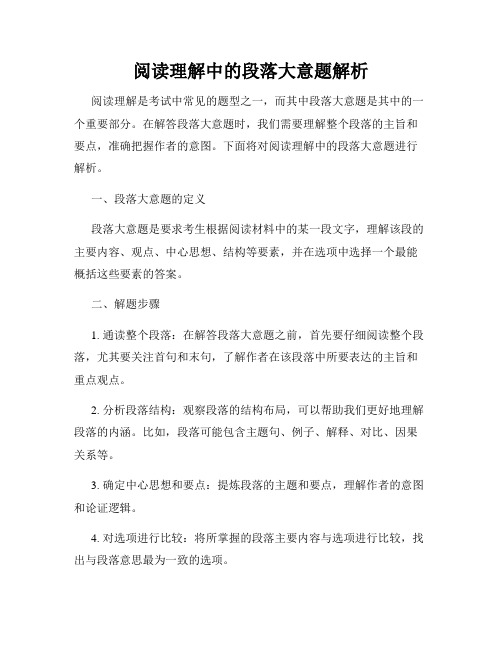
阅读理解中的段落大意题解析阅读理解是考试中常见的题型之一,而其中段落大意题是其中的一个重要部分。
在解答段落大意题时,我们需要理解整个段落的主旨和要点,准确把握作者的意图。
下面将对阅读理解中的段落大意题进行解析。
一、段落大意题的定义段落大意题是要求考生根据阅读材料中的某一段文字,理解该段的主要内容、观点、中心思想、结构等要素,并在选项中选择一个最能概括这些要素的答案。
二、解题步骤1. 通读整个段落:在解答段落大意题之前,首先要仔细阅读整个段落,尤其要关注首句和末句,了解作者在该段落中所要表达的主旨和重点观点。
2. 分析段落结构:观察段落的结构布局,可以帮助我们更好地理解段落的内涵。
比如,段落可能包含主题句、例子、解释、对比、因果关系等。
3. 确定中心思想和要点:提炼段落的主题和要点,理解作者的意图和论证逻辑。
4. 对选项进行比较:将所掌握的段落主要内容与选项进行比较,找出与段落意思最为一致的选项。
三、解题技巧1. 通过首尾句理解中心:首尾句往往能够明确给出段落的主题和目的,所以在解题过程中要特别关注这两句。
2. 确定段落的角色:不同段落在文章中担负着不同的角色,有些段落用来阐述问题,有些用来解释论证,有些用来提供例证等,理解段落在整篇文章中的作用能够帮助我们更准确地把握段落大意。
3. 注意段落的连接词:段落中的转折词、因果关系词、并列连词等,可以帮助我们理解段落内部的逻辑关系,把握段落的主要思路。
四、练习题例题一:(1)Jane is a talented singer. (2)Since she was a child, she has always loved singing. (3)She joined the school choir at the age of 10 and has won many singing competitions. (4)Her voice is sweet and powerful, and her performances always touch the hearts of the audience. (5)In the future, she dreams of becoming a famous singer and bringing happiness to more people.The paragraph mainly discusses ________.A. the power of musicB. the dream of a talented singerC. the singing competitions Jane has wonD. the school choir and Jane's participation解析:通过分析每个句子的要点,我们可以注意到该段落主要描述了Jane的才艺和她的梦想,因此答案选B。
三年级阅读理解之概括段落大意
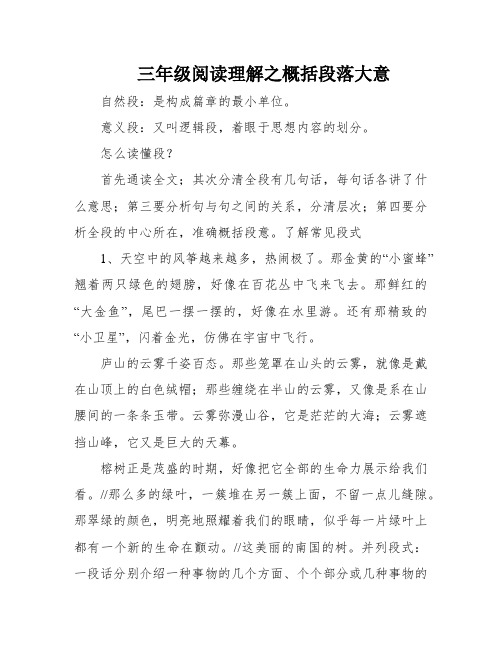
三年级阅读理解之概括段落大意自然段:是构成篇章的最小单位。
意义段:又叫逻辑段,着眼于思想内容的划分。
怎么读懂段?首先通读全文;其次分清全段有几句话,每句话各讲了什么意思;第三要分析句与句之间的关系,分清层次;第四要分析全段的中心所在,准确概括段意。
了解常见段式1、天空中的风筝越来越多,热闹极了。
那金黄的“小蜜蜂”翘着两只绿色的翅膀,好像在百花丛中飞来飞去。
那鲜红的“大金鱼”,尾巴一摆一摆的,好像在水里游。
还有那精致的“小卫星”,闪着金光,仿佛在宇宙中飞行。
庐山的云雾千姿百态。
那些笼罩在山头的云雾,就像是戴在山顶上的白色绒帽;那些缠绕在半山的云雾,又像是系在山腰间的一条条玉带。
云雾弥漫山谷,它是茫茫的大海;云雾遮挡山峰,它又是巨大的天幕。
榕树正是茂盛的时期,好像把它全部的生命力展示给我们看。
//那么多的绿叶,一簇堆在另一簇上面,不留一点儿缝隙。
那翠绿的颜色,明亮地照耀着我们的眼睛,似乎每一片绿叶上都有一个新的生命在颤动。
//这美丽的南国的树。
并列段式:一段话分别介绍一种事物的几个方面、个个部分或几种事物的特点,其内容之间就构成了并列关系。
可把并列的部分进行分层。
海底的岩石上长着各种各样的珊瑚。
有的像展开的花朵,有的像分枝的鹿角。
海参到处都是,在海底懒洋洋的蠕动。
大龙虾全身皮甲,划过来,划过去,样子挺威武。
概括XXX:转折段式:在一段话里,后面的意思和前面的意思相反或相对,这样的句子间就构成了转折关系,可以在转折处分层。
转折词:可是、可是、而等等。
在这类段式中,可以在转折处罚为两层。
讲义是同学们的“良师益友”。
一本讲义颠末很多叔叔、阿姨的精心编写、印刷、装订才能完成。
要花费叔叔、阿姨很多心血啊!可是,有的同学不顾惜讲义。
他们有的在讲义上乱涂乱画,有的给插图上的人物画上了花脸,戴上了“眼睛”。
概括段意:小精灵修炼场:这些小虾真风趣。
它们吃食物很小心,总是先用钳子碰一下,然后赶忙今后退,接着再碰一下,再退,直到觉得没有危险了,才用了钳子捧着吃起来。
- 1、下载文档前请自行甄别文档内容的完整性,平台不提供额外的编辑、内容补充、找答案等附加服务。
- 2、"仅部分预览"的文档,不可在线预览部分如存在完整性等问题,可反馈申请退款(可完整预览的文档不适用该条件!)。
- 3、如文档侵犯您的权益,请联系客服反馈,我们会尽快为您处理(人工客服工作时间:9:00-18:30)。
阅读指导之概括段落大意(有答案)阅读文章时,养成一边阅读一边概括段意的好习惯,对自己写作文时选材组材,布局谋篇都是有帮助的。
要求概括段意做到言简意明,不能罗里罗嗦,说个没完,什么是准确呢?就是抓住段的实质,不要偏离段的主要内容。
(一)用段的中心句概括段落大意。
△中心句指明段的写作范围△中心句突出段的主要内容△中心句归纳出段的思想要点例1小城里每个庭院都栽了很多树。
有桉树、椰子树、橄榄树、凤凰树,还有别的亚热带树木。
初夏,桉树叶子散发出来的香味,飘得满街满院都是。
凤凰树开花了,开得那么热闹,小城好像笼罩在从天际飘来的一片片红云中。
例2童第周二十八岁的时候,得到亲友的资助,到比利时去留学,跟一位在欧洲很有名的生物学教授学习。
一起学习的还有别的国家的学生。
旧中国的贫穷落后,在世界上没有地位,外国学生瞧不起中国学生。
童第周暗暗下决心,一定要为中国人争气。
(二)用文章重点句概括段意有的文章段落中,作者在叙述事实以后,用抒情议论的方法,写出了自己的感想、体会。
这些感想,往往概括了全文的主旨,点明了段的中心。
阅读时可以直接引用作为段的段意。
例3今天清早,雪停了,天也晴了。
一轮红日升起来,把雪后的大地照得分外耀眼。
茫茫田野一片雪白,巍巍群山遍身银装,好一派壮丽雄伟的北国风光,好一幅瑞雪丰年的喜人图画。
(三)用自己的语言概括段意段落中没有直接表述中心的语句就需要用自己的语言进行表述。
步骤:1. 段落中共有几句话。
2. 每句话讲的是什么意思。
3. 可以分为几层意思4. 每层讲的是什么内容。
5. 归纳每层的意思,进而概括出段的主要意思。
例4那一天,天还没有亮,我们连悄悄地摸进“三九一”高地下面的山坳,潜伏在一条比较隐蔽的山沟里。
太阳渐渐地爬上山头。
我发现前面六十多米就是敌人的前沿阵地,不但可以看见铁丝网和胸墙,还可以看见地堡和火力点,甚至连敌人的讲话都听得见。
敌人居高临下,当然更容易看见我们。
我们趴在地上必须纹丝不动,咳嗽一声或蜷一下腿,都可能被敌人发觉。
他们身上披着厚厚的茅草作为伪装,猛一看去,很难发现他们。
我又看了看伏在身边不远的邱少云。
他也全身伪装,隐蔽得更好,相隔这么近,我几乎找不到他。
总结概括段落大意的方法:第一,段意应该是一段文章中的主要内容,而不应该是思想内容的概括。
第二,段意一般我们用陈述句表达。
每段段意连起来应当反映出全篇文章的主要内容。
第三,认真读懂段的主要内容,理解句与句、层与层之间的关系才能抓住段的主要内容,准确地概括出段落大意。
练习(一)今年夏天的一个下午,“金皇后”耕麦茬地去了。
忽然刮起一阵东南风,天上布满乌云,雷声紧跟着闪电,震得窗户都发抖,大雨像从天上倒下来似的。
当时赵大爷正在剃头,刚剃了半个脑袋,一看暴风雨来了,赶紧跑回屋里,从炕上揭起一条毯子,拔腿就往外跑。
他一口气跑到地里,把毯子给“金皇后”搭在身上,拉了它回来。
回到家里,他自己淋得像刚从水里捞出来的一样了。
1. 把上边的这段话分成三层,用“||”标出。
2. 写出每层的意思。
①②②(二)朱德委员长70多岁的时候。
又重返云南视察工作,这里是他早年生活和战斗过的地方。
几十年的时间过去了。
旧地重游,他看到解放后云南工农业生产欣欣向荣的景象,心情格外畅快。
视察期间,省委负责同志一再嘱咐接待的同志,一定要把朱委员长的生活安排好。
可是朱德同志对过分的招待不接受,每顿饭菜都要求做得简单些。
负责接待的同志心里十分不安,还是想方设法为朱委员长改善饮食的花样。
他们听说,长征时朱委员长很喜欢吃野菜,所以有一天,用一种野菜,做了一个“金雀花鸡蛋”,送给朱委员长吃,朱委员长吃了很高兴。
于是,接待人员经常做些野菜给朱委员长吃,朱委员长很满意。
后来,省委负责同志来检查接待工作,发现朱委员长每天的伙食费比规定的标准低得很多,就批评了接待人员,并问他们:“什么最适合老年人吃?”接待人员回答:“燕窝和银耳对老年人较为适宜。
”省委负责同志听了,告诉接待人员以后要做这些珍贵的滋补品给朱委员长吃。
第二天,当服务员把一碗“燕窝煮鸡蛋”端到桌上时,朱委员长很不高兴,马上把负责接待的人找来,批评说:“现在,我们每天吃得已经很不错了,为什么要弄些名贵的东西来?”接待人员忙解释说:“省委领导怕影响您的健康,特意嘱咐要保证您的营养。
”朱委员长说:“这次燕窝的钱我出,下次你们要是再弄来,我就不吃了!”按照省委领导同志的指示,过了几天,接待人员又硬着头皮做了一次燕窝,送到朱委员长那儿。
这下委员长可生气了,他一口也不吃,还让康大姐(康克清老奶奶)去商店了解燕窝的价格。
最后,严厉地批评了接待人员。
省委领导知道后,再也不强调给他做珍贵的滋补品吃了。
后来,接待人员常给朱委员长做些青蚕豆焖饭、香椿、豌豆尖等,朱委员长吃得很香,很满意。
朱委员长在饮食上如此俭朴,对大家是很好的教育。
1. 给文章加个恰当的题目。
2. 结合上下文解词:欣欣向荣:畅快:3. 把第2—11自然段分成三部分。
第一部分:____________________________________________ 第二部分:____________________________________________(三)爸爸错怪了我语文课上,倪老师正在有感情地朗读《冬眠》。
她的语调十分动人,我们班上每一个同学都非常喜欢听,我还常常模仿她的语调朗读课文呢。
忽然,我听到倪老师把惊蛰的“蛰”读成了第四声。
“老师,您读错了。
”我站起来说道。
倪老师先是愣了愣,看了看我,随即让我坐下。
这时,前后左右的同学都向我瞪眼睛,歪鼻子……放学回家,我把语文课上发生的事告诉了爸爸,没想到爸爸发火了,他冲着我说道:“你还懂不懂礼貌?你这是对老师不尊重的行为。
”“老师是你的长辈,乱提意见这还了得?”“这是你的看法,我们老师可从来没这样说过。
”我嘟着嘴,只是轻轻地说了一句。
谁知爸爸听见了,走过来,朝我就是一巴掌,我委屈地哭了。
第二天,倪老师知道了,就到我家来访问,她对爸爸说:“昨天,刘刚同学向我指出了读错的字音,下课后,我查了查字典,刘刚的意见是正确的。
”倪老师又回过身来对我说:“刘刚,谢谢你向我指出了错误,希望你今后再向我提出更多的意见。
”我低着头,激动地说:“我不该不举手发言。
……”倪老师走后,爸爸抚摸着我的头说:“是爸爸不好,爸爸错怪了你。
”1.联系课文解释词语。
(1)十全十美:_________________________________________(2)嘴硬:_____________________________________________2.用“‖”将短文分成三段,写出各段大意。
_________________________________________________________________ _________________________________________________________________ _________________________________________________________________(四)情谊1 昨夜,一场无情的大火,把我家的一切都烧成了灰烬。
第二天一早,妈妈催我去上学。
书没了,书包也没了……叫我怎能去上学呢?我带着悲伤和疲劳,慢慢地朝学校走去。
‖2 教室里,同学们都在读书,我低着头走进了教室。
不知是谁小声说了声:“玲玲来了”。
同学们不约而同地放下课本,抬起头用同情的目光看着我。
大家都没有说话,但分明看得出大家又都想说些什么。
教室里出奇的静,好像没有人一样。
这时,中队长方萍手拿一个大纸包走过来,对我说:“别难过!这些都是同学们送给你的学习用品。
我给你买了一条红领巾和中队委员的标志。
来,我给你戴上”。
3 “玲玲,你收下吧!”4 “玲玲,这是我爸爸给我买的精致的彩色笔,我把它送给你。
”5 “玲玲,这个多功能文具盒是我姑姑给我的生日礼物,你拿去用吧!”6 一声声感人的话语,一张张亲切的面容,一双双同情的眼睛,温暖了我那颗极度悲伤的心。
‖7 “当当当……”上课铃响了,班主任走进教室。
她爱抚地摸着我的头,关切地问:“玲玲,你爸爸妈妈好吗?”我点点头。
接着,她给我一套课本和一件崭新的连新裙。
并深情地对我说:“这连衣裙是给我女儿买的,你和我女儿差不多大,穿在身上一定很合身。
还有什么困难只管说,有我们大家呢!”我双手接过连衣裙,含着眼泪深深地给老师鞠了一个躬。
‖8 我双手捧着课本,看着桌上的学习和生活用品,我真想大哭一场。
我用力咬着嘴唇,极力控制自己。
可是不知为什么那大颗大颗的泪珠还是不停地滚落下来……‖1.写出下列词语的近义词。
悲伤()疲劳()关切()2.用“~~~~”线画出描写同学们神态、动作的语句。
3.用“──”线画出描写老师神态动作的语句。
4.短文用“‖”线已分为四段,请写出各段段意。
________________________________________________________________________________________________________________________________________________________________________________________(五)红领章1 课后,同学们到操扬上去了。
没等我走出教室,陈老师笑着对我说:“李伟,你的信。
”我高兴地跑到老师面前,激动地用双手接过这盼望已久的回信──从老山前线来的信。
我小心翼翼地把信拆开。
里面有一对红领章,我兴奋地拿出来。
它是平形四边形的,表面有一层平绒,红红的,显得特别鲜艳。
2 我望着它,眼前浮现出这样的情景——3 一个年轻的战士身穿军装,手握钢枪,衣领上嵌着一对红领章,他挺身跃出战壕,冲向魂飞胆破的敌人;在猫耳洞里,在微弱的灯光下,两名神炮手,正聚精会神地擦着炮弹,跳动着的烛光把领章映得通红;一位失去右臂的重伤员,躺在前方医院的病床上。
这位身残志坚的好班长,一再要求返回战场,他的领章红艳艳的,比鲜血还红,发出闪闪的红光。
4 我双手捧着这对领章,它仿佛在闪光,闪着耀眼的光芒。
啊,红领章,我爱你!1.用‖给短文分段,并概括段落大意。
_________________________________________________________________________________________________________________________________________________________(六)_________________(1)蝴蝶花生在草丛里,从紫色的花_____(辩、瓣、掰、半)里不时地飘散出一丝淡淡的______(青、清、轻)香,逗引着蜜蜂、蝴蝶从远处飞来。
